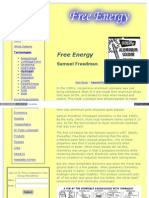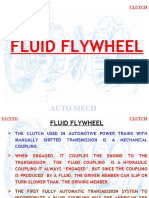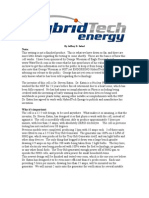CHEMALLOY - A New Alloy For The Science Student
CHEMALLOY - A New Alloy For The Science Student
Uploaded by
Peter Benedikt WeberCopyright:
Available Formats
CHEMALLOY - A New Alloy For The Science Student
CHEMALLOY - A New Alloy For The Science Student
Uploaded by
Peter Benedikt WeberOriginal Title
Copyright
Available Formats
Share this document
Did you find this document useful?
Is this content inappropriate?
Copyright:
Available Formats
CHEMALLOY - A New Alloy For The Science Student
CHEMALLOY - A New Alloy For The Science Student
Uploaded by
Peter Benedikt WeberCopyright:
Available Formats
Science and Mechanics Magazine Article - May 1961
CHEMALLOY - A New Alloy for the Science Student Originally conceived as a soldering alloy, this patented substance has anti-friction properties, will aerate soil, improves seed germination, stimulates plant growth, will generate electricity, and ???? By Samuel Freedman What relation there can be between soldering aluminum and promoting the growth of huckleberries is hard to see --- yet in the broadest view, scientists say, all things are in some way interrelated. Chemalloy, with its strangely diverse properties seems to support this view. Put a Chemalloy Rod in plain water (Fig. 1) and you have a battery of .55 volt potential that will last as long as the rod is kept wet, generating enough power to operate a voltmeter, milliameter or oscilloscope. In different liquids, voltage varies from almost zero for petroleum to 1.1 for certain types of chili sauce. As a bearing material, Chemalloy in a solid dry state withstands friction without coolant or lubricant. Chemalloy powderized to about 1,000,000 particles per pound exhibits the same electrical properties (Fig. 2) as the solid rod. Here it generates slightly more than .5 volt, and in addition decomposes the water, liberating hydrogen. * solid rod decomposes water aided by electrolysis. This process is further examined in Fig 3. First fill three graduated cylinders with water, one cold, the second warm, and the third hot. Add equal amounts of Chemalloy to each graduated cylinder. Instantly, the graduated cylinder containing hot water liberates hydrogen (Fig. 3A). Heat is generated by the reaction so that with the passage of a few minutes (Figs. 3B and C) the three graduated cylinders are equally warm and hydrogen production in all three is the same. One of the Most Significant Uses of powdered Chemalloy may be the warming and loosening of soils that are too cold or compact for optimum seed generation and plant growth. The warming and aeration of soil on a laboratory basis is shown in Fig. 4. A sample of dry soil is placed on top of powdered Chemalloyinaglasscase.Notethetemperaturerisefrom94F.to126F.Voltageremainsapproximatelyat.6. From this point on, voltage will remain constant, but soil temperature will decline and finally stabilize at a point a few degrees above the environmental temperature. The electrical action will continue and will generate warmth at this reduced magnitude. To date, the capability of Chemalloy to generate electricity in water has been observed for seven continuous years, and no limit is known. The liquid, rather than the metal is the substance which is consumed and must be replaced. A Provincial Horticulture Station in Alberta, Canada, summarizes an experiment in seed germination as follows:
Vegetable Cucumber Red Beet Lettuce Leek Carrot %germinated (Chem. Treated) 50 96 64 86 68 %germinated (untreated) 16 70 34 54 32
The assistant superintendent supervising this experiment stated that the addition of Chemalloy powder resulted in speedier germination of seeds as well as larger percentages germinated. Initial growth of the plants after emergence was also more rapid in the case of treated seeds. For field crops, Chemalloy is applied at the rate of one to five pounds per acre, in the row or hill with the seeds. It is not broadcast over the entire field area, as this would waste material. It needs to be buried where it will be in contact with soil moisture since it is inert when dry. The peach and nectarine trees in Fig. 5 were planted in poor compact clay soil in El Cajon, Calif., and stands in sharp contrast to anything else in the area havinggrownin1yearstotheheightshownfrom1-in. diameter stubs. Chemalloy Was Developed in 1951 as a fluxless aluminum solder alloy, by combining zinc and lead in the presence of raw muriatic acid, at a temperatureof1500F.Originallyexplosive,todaytheprocessisreducedtoviolentboilingandprolongedtofiveminutes,bytheuseofporouscopper slag and finely divided charcoal. What uses Chemalloy may have beyond those outlined in this article can only be guessed at. Readers may communicate with the inventor, Samuel Freedman, in care of Chemalloy Electronics Corp., Santee, Calif., if they have special interest or need for more specific information, and for samples of Chemalloy which will be supplied for a nominal charge of 25each to cover cost of packaging and mailing. If a working quantity of material is also desired as a fluxless aluminum solder complete with instructions, add 25additional. EDITOR'S NOTE: We are happy are happy to present the science student this exposition of Chemalloy and its properties as told to Science and Mechanics by its inventor, Samuel Freedman. This new substance, granted U. S . Patents No. 2,796,345 (Process of Producing Lead-Zinc Alloys) - June 18, 1957 and No. 2,927,856 (Multi-Purpose Alloys of Controlled Homogeneity), may have many uses not yet discovered. As a project for Science Fair participants it offers interesting possibilities for original research. Copies of the patents may be obtained from the U. S. Patent Office, Washington, D. C., for $3.00 each. Samples of Chemalloy may be purchased from Nu Energy Horizon's online orderform.
Generated with www.html-to-pdf.net
Page 1 / 2
Other Amazing Applications of Chemalloy
Nu Energy Alternative Energy Research
Nu Energy Research Laboratories, P. O. Box 22, Rumney, New Hampshire 03266-0022 USA Copyright 2003 - All Rights Reserved
Generated with www.html-to-pdf.net
Page 2 / 2
You might also like
- User Manual 13398Document44 pagesUser Manual 13398Diy DoeNo ratings yet
- Poor Man Hydrogen Generator on Demand: Smcs Hho Stephens Multi Cell Systems Hydrogen Generator on DemandFrom EverandPoor Man Hydrogen Generator on Demand: Smcs Hho Stephens Multi Cell Systems Hydrogen Generator on DemandRating: 5 out of 5 stars5/5 (2)
- ERR Power Station Project BookletDocument18 pagesERR Power Station Project BookletAnonymous C0KBah6TEqNo ratings yet
- 2kW Free Energy Device - Don SmithDocument5 pages2kW Free Energy Device - Don SmithJake Mitchell80% (30)
- 2kW Free Energy Device - Don SmithDocument5 pages2kW Free Energy Device - Don SmithJake Mitchell80% (30)
- Container Paving Design PDFDocument21 pagesContainer Paving Design PDFTrong Tran100% (1)
- GEET - PANTONE REACTOR - Plasma System - Water As FUELDocument27 pagesGEET - PANTONE REACTOR - Plasma System - Water As FUELashwin shindhe100% (2)
- Geet EngDocument10 pagesGeet EngNideYuanfenNo ratings yet
- Hilux GEET Conversion ConstructionDocument6 pagesHilux GEET Conversion ConstructionKumaran Sanmugathasan100% (1)
- Tkramer Part2-Electrolysis NHO2Document17 pagesTkramer Part2-Electrolysis NHO2danevide100% (1)
- Bill Williams Gas Splitter Dry CellDocument4 pagesBill Williams Gas Splitter Dry CellCiprian ALNo ratings yet
- Buie UpgradeDocument4 pagesBuie UpgradeNatasaBugaian100% (1)
- Stanley Meyer: Water Fuel CellDocument17 pagesStanley Meyer: Water Fuel CellBernardo121351100% (1)
- Tulip HydroponicsDocument15 pagesTulip HydroponicsGman00No ratings yet
- Don Smith Energy GuideDocument44 pagesDon Smith Energy GuidePeter Benedikt Weber100% (2)
- Nemescope NemeskopDocument42 pagesNemescope NemeskopPeter Benedikt WeberNo ratings yet
- Housing-Problems and Solutions in IndiaDocument17 pagesHousing-Problems and Solutions in Indiaruksar33% (3)
- Garrett BlueDocument11 pagesGarrett BlueAleksa Nataša RančićNo ratings yet
- Dony WatssDocument49 pagesDony WatssvbugaianNo ratings yet
- Alcohol Fuel 2001Document3 pagesAlcohol Fuel 2001tibork1No ratings yet
- The Richard Clem EngineDocument24 pagesThe Richard Clem EngineDimple Soni100% (1)
- WWW Free Energy Ws Samuel Freedman HTMLDocument3 pagesWWW Free Energy Ws Samuel Freedman HTMLWEEGE33No ratings yet
- Torodial TrStanlyDocument5 pagesTorodial TrStanlyfred_m_48601100% (1)
- US4143639 Friction Heat Space Heater, Eugene FrenetteDocument6 pagesUS4143639 Friction Heat Space Heater, Eugene FrenetteBastien Gall de SilléNo ratings yet
- The Quickest and Easiest Steps To Set-Up The Simple Water Fuel-How It WorksDocument11 pagesThe Quickest and Easiest Steps To Set-Up The Simple Water Fuel-How It WorksdavomusikNo ratings yet
- Edison Cell Rejuvenation 85 Yr-Old 13. DeMarDocument5 pagesEdison Cell Rejuvenation 85 Yr-Old 13. DeMarjro84No ratings yet
- Fluid Flywheel: Auto MechDocument6 pagesFluid Flywheel: Auto MechsalmapratyushNo ratings yet
- Top TenDocument12 pagesTop TentelkonNo ratings yet
- 3 Ijeeerfeb20173Document10 pages3 Ijeeerfeb20173TJPRC PublicationsNo ratings yet
- Replicating The Earth Captor of Barbosa and LealDocument13 pagesReplicating The Earth Captor of Barbosa and LealfolitasNo ratings yet
- DonnieDocument9 pagesDonniepranalar100% (1)
- Water DopingDocument19 pagesWater Dopingvanderwalt.paul2286No ratings yet
- Mototaro Eguchi - Electret PDFDocument2 pagesMototaro Eguchi - Electret PDFLeonardo Martone100% (1)
- Fuel From Water (Excerpt)Document5 pagesFuel From Water (Excerpt)bcrenshaw2100% (3)
- Patent Us 20090096219 Annis EberlyDocument15 pagesPatent Us 20090096219 Annis EberlyCentro Astrologico de MisionesNo ratings yet
- Didactico - Water Car Engine Plans Manual - Hydrogen Fuel - Use Tap Water (En Inglés)Document14 pagesDidactico - Water Car Engine Plans Manual - Hydrogen Fuel - Use Tap Water (En Inglés)Manuel BolonNo ratings yet
- HydroxyDocument343 pagesHydroxyJorge AlonsoNo ratings yet
- Geet Motor Plasma de Agua LinksDocument2 pagesGeet Motor Plasma de Agua LinksDioxCloChileNo ratings yet
- Naudin PantoneDocument9 pagesNaudin PantoneRizal FalevyNo ratings yet
- Motionless Free Energy: Because It Opposes Itself, It Can Never Be More Than 100% Efficient. We AreDocument6 pagesMotionless Free Energy: Because It Opposes Itself, It Can Never Be More Than 100% Efficient. We AreRolling76No ratings yet
- Tesla Battery Switch 2.PGFEDDocument12 pagesTesla Battery Switch 2.PGFEDohoboho79100% (1)
- GEET-Small Engine Conversion PlansDocument19 pagesGEET-Small Engine Conversion PlansCristo_Alanis_8381No ratings yet
- Torch ManualDocument3 pagesTorch ManualterapeutasordoNo ratings yet
- Tesla'S Magnifying TransmitterDocument5 pagesTesla'S Magnifying TransmitterharishkumarsinghNo ratings yet
- Use Water For Fuel GeneratorDocument10 pagesUse Water For Fuel GeneratordavidNo ratings yet
- A Practical Guide For HOHDocument164 pagesA Practical Guide For HOHDan AngheleaNo ratings yet
- Muammer YILDIZ - : Update - 5-2010Document43 pagesMuammer YILDIZ - : Update - 5-2010bento broli100% (1)
- Hybrid Tech Eat On Fuel CellDocument13 pagesHybrid Tech Eat On Fuel CellhhojonNo ratings yet
- Non-Conventional Free Energy Devices Examples and Practical ApplicationsDocument4 pagesNon-Conventional Free Energy Devices Examples and Practical ApplicationsSivakumar SelvarajNo ratings yet
- Hydroxy BoostersDocument269 pagesHydroxy Boostersapi-3725726100% (5)
- Let'S Get Familiar With Your New H.O.G. Fuel Cell InstallationDocument4 pagesLet'S Get Familiar With Your New H.O.G. Fuel Cell Installationgabriela69sNo ratings yet
- A Free Energy Machine by WANGDocument4 pagesA Free Energy Machine by WANGmorseeNo ratings yet
- Bedini Beginners (324-400)Document77 pagesBedini Beginners (324-400)ALEJANDRO CIPAMOCHA PEDRAZANo ratings yet
- Chas Campbell DetailedDocument5 pagesChas Campbell DetailedJerel John VelardeNo ratings yet
- Star in A JarDocument14 pagesStar in A JarJohn100% (1)
- Stanley Meyer Big Bobbin Builders Guide 2019 v1: Very Rare Guide for How to Assemble Water Fueled injector tri-filar bobbinFrom EverandStanley Meyer Big Bobbin Builders Guide 2019 v1: Very Rare Guide for How to Assemble Water Fueled injector tri-filar bobbinNo ratings yet
- Thermalloy US Patent # 2,796,345 Samuel FreedmanDocument9 pagesThermalloy US Patent # 2,796,345 Samuel FreedmanvalencamacieiraNo ratings yet
- The Composting Greenhouse by Bruce FulfordDocument24 pagesThe Composting Greenhouse by Bruce FulfordWyoming Native Plant Society100% (3)
- Desalination: Z.M. Omara, Mofreh H. Hamed, A.E. KabeelDocument7 pagesDesalination: Z.M. Omara, Mofreh H. Hamed, A.E. KabeelResearcherzNo ratings yet
- Electro CulturaDocument17 pagesElectro Culturav_varlamNo ratings yet
- Some Quality Characteristics of Solar-Dried Cocoa Beans in ST LuciaDocument6 pagesSome Quality Characteristics of Solar-Dried Cocoa Beans in ST LuciaFEREN DILA AVISKANo ratings yet
- Phosphate Fertilizer Production - From The 1830's To 2011 and BeyondDocument6 pagesPhosphate Fertilizer Production - From The 1830's To 2011 and BeyondJavier Alejandro RodriguezNo ratings yet
- Kagramian Report 2Document12 pagesKagramian Report 2api-700030358No ratings yet
- Geothermal Energy PrimerDocument12 pagesGeothermal Energy PrimerspithridatesNo ratings yet
- TDCS InformationDocument19 pagesTDCS InformationPeter Benedikt WeberNo ratings yet
- The Anatomy of Russian Information WarfareDocument37 pagesThe Anatomy of Russian Information WarfarePeter Benedikt WeberNo ratings yet
- TDCS GerätDocument18 pagesTDCS GerätPeter Benedikt WeberNo ratings yet
- High Frequency Plasma Circuit (Electronic Ion Pump)Document3 pagesHigh Frequency Plasma Circuit (Electronic Ion Pump)Peter Benedikt Weber100% (2)
- Caelius CoE 2023 HyderabadDocument24 pagesCaelius CoE 2023 Hyderabadsvkr00001No ratings yet
- Duplexer For UMTS CositingDocument2 pagesDuplexer For UMTS Cositingpandavision76No ratings yet
- 3 - Pump-Pipeline System Analyses and DesignDocument9 pages3 - Pump-Pipeline System Analyses and DesignAnonymous 7oXNA46xiNNo ratings yet
- Booking.com.docxDocument7 pagesBooking.com.docxAnonymous qZAzFiSNo ratings yet
- Measuring Bottle CapsDocument7 pagesMeasuring Bottle Capsapi-512522872No ratings yet
- Study Centre January 9, 2018Document50 pagesStudy Centre January 9, 2018Joshua BlackNo ratings yet
- USA v. CA DismissalDocument7 pagesUSA v. CA DismissalMax GreenwoodNo ratings yet
- ES16-16RAS - Manual de Serviços (2015)Document83 pagesES16-16RAS - Manual de Serviços (2015)JoséNo ratings yet
- MSDOS Programming InfoDocument631 pagesMSDOS Programming Infopzpanzer101No ratings yet
- 15076/TRIVENI EXP Sleeper Class (SL)Document2 pages15076/TRIVENI EXP Sleeper Class (SL)SURABHI ASTHANANo ratings yet
- Whatsapp Hacking ! Complete Guide: Designed By:-@Graphicdesignergbd (Instagram)Document6 pagesWhatsapp Hacking ! Complete Guide: Designed By:-@Graphicdesignergbd (Instagram)Faisal BiyabaniNo ratings yet
- G.R. No. 209014Document4 pagesG.R. No. 209014modimanahanNo ratings yet
- Classroom Observation and LAC - PLCDocument27 pagesClassroom Observation and LAC - PLCJhay-are PogoyNo ratings yet
- Group 1 (Thesis)Document34 pagesGroup 1 (Thesis)천사노리No ratings yet
- Vdoc - Pub Processing An Introduction To ProgrammingDocument571 pagesVdoc - Pub Processing An Introduction To ProgrammingAxel Ortiz RicaldeNo ratings yet
- Specialuseproducts: Series FeaturesDocument1 pageSpecialuseproducts: Series Featuresapi-170472102No ratings yet
- Library Disasters in Developing Countries-A Literature Review of Experiences and Way ForwardDocument22 pagesLibrary Disasters in Developing Countries-A Literature Review of Experiences and Way ForwardRoland IzuagbeNo ratings yet
- Roof DrainsDocument1 pageRoof DrainsAhmed RamzyNo ratings yet
- Presentation2 Design of RC - GirderDocument18 pagesPresentation2 Design of RC - Girderrekcah ehtNo ratings yet
- Doctor (A2) : Did You Understand The Text?Document2 pagesDoctor (A2) : Did You Understand The Text?Hachani SoumayaNo ratings yet
- WT Ramsay LTD V Inland Revenue Commissioners (1981) UKHL 1 (12 March 1981)Document19 pagesWT Ramsay LTD V Inland Revenue Commissioners (1981) UKHL 1 (12 March 1981)bharath289No ratings yet
- Data AnalyticsDocument6 pagesData Analyticsalooreprasad45No ratings yet
- Forensic Auditing - Chapter 5Document3 pagesForensic Auditing - Chapter 5Salsa ArdilaNo ratings yet
- Journal Reading Kulit OkDocument4 pagesJournal Reading Kulit OkNida Fithria FadhilaNo ratings yet
- Call of Duty CheatsDocument16 pagesCall of Duty CheatsLouisaNo ratings yet
- Rule The Audio-Streaming Industry With A Top-Notch Spotify CloneDocument11 pagesRule The Audio-Streaming Industry With A Top-Notch Spotify Clonewentworth miller100% (1)
- Chapter 22 - Modifications To The Independent Auditor's Report - CANOSA, Danica Mae TDocument33 pagesChapter 22 - Modifications To The Independent Auditor's Report - CANOSA, Danica Mae TDanica Mae CanosaNo ratings yet
































































































